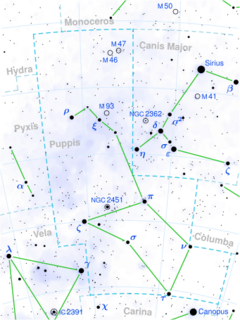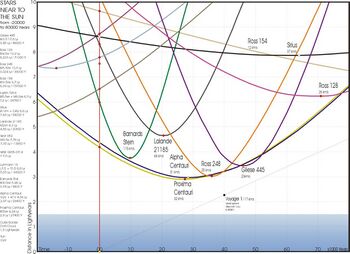Astronomy:WD 0810–353
Coordinates: ![]() 08h 12m 27.07s, −35° 29′ 43.3″
08h 12m 27.07s, −35° 29′ 43.3″
| Observation data Equinox J2000.0]] (ICRS) | |
|---|---|
| Constellation | Puppis |
| Right ascension | 08h 12m 27.06600s[4] |
| Declination | −35° 29′ 43.3241″[4] |
| Apparent magnitude (V) | 14.469[5] |
| Characteristics | |
| Evolutionary stage | white dwarf |
| Spectral type | DAH[2] |
| Astrometry | |
| Radial velocity (Rv) | −373.74±8.18[4] km/s |
| Proper motion (μ) | RA: −365.479[4] mas/yr Dec.: −329.204[4] mas/yr |
| Parallax (π) | 89.5064 ± 0.0155[4] mas |
| Distance | 36.439 ± 0.006 ly (11.172 ± 0.002 pc) |
| Details | |
| Mass | 0.63[2] M☉ |
| Radius | 0.01[6] R☉ |
| Luminosity | 0.00017[7] L☉ |
| Surface gravity (log g) | 8.09[2] cgs |
| Temperature | 6,093[2] K |
| Age | 2.7[2][lower-alpha 1] Gyr |
| Other designations | |
| Database references | |
| SIMBAD | data |
WD 0810-353 (UPM J0812-3529) is a white dwarf currently located 36 light-years (11 parsecs) from the Solar System. This stellar remnant may approach the Solar System 29,000 years from now at a distance of around 0.15 parsecs, 0.49 light-years or 31,000 astronomical unit|AU from the Sun, crossing well within the proposed boundaries of the Oort cloud.[3] Such close proximity will almost certainly make its flyby the closest in the future, until the flyby of Gliese 710 occurs around 1.14 million years after the dwarf's flyby.
Observations
WD 0810-353 is a dim object with an apparent magnitude of 14.5[2] in the southern constellation of Puppis. Its motion perpendicular to the line of sight is considerable; it is consistently listed as a high proper motion star.[9]
Physical properties
WD 1810-353 is a white dwarf of spectral type DAH[2] with a very strong magnetic field, perhaps as strong as 30 MG.[2] It has a mass of 0.63 M☉ and an age of 2.7 billion years;[2] its effective temperature is 6,093 K[2] or 6,273 K[10]. Gaia Data Release 3 (Gaia DR3) gives a value of its radial velocity of −373.74±8.18 km/s which could be incorrect because the Gaia software pipeline does not include any template for white dwarfs.[11] Alternate analyses suggest a radial velocity as high as −4,248 km/s.[12]
Flyby
Considering the values from Gaia DR3, WD 1810-353 will traverse the Oort cloud, disturbing the population of comets there, Given its mass such an encounter like Gliese 710, would not cause a non-negligible orbital change to the Pluto system and Neptune resonant object.[3] Both the minimum approach distance and the timing of this flyby depend strongly on the value of the radial velocity.[11] The Gaia DR3 mean BP/RP low-resolution spectrum suggests that WD 0810-353 could be a hypervelocity runaway white dwarf ejected during a type Ia supernova explosion.[12] Extensive analyses show that the relative velocity during the flyby could be high enough, or the minimum approach distance large enough, to prevent any significant perturbation on the Oort cloud.
Very strong and complex magnetic field
New observational data confirmed the very strong magnetic field of this white dwarf and provided a new value of the radial velocity,+83±140 km/s[13]. With this value, the future flyby to the Solar System is unremarkable.[12][13]
Notes
- ↑ This is the "cooling age", the length of time since the object became a white dwarf.
References
- ↑ Jump up to: 1.0 1.1 1.2 "UPM J0812-3529". SIMBAD. Centre de données astronomiques de Strasbourg. http://simbad.u-strasbg.fr/simbad/sim-basic?Ident=UPM+J0812-3529.
- ↑ Jump up to: 2.00 2.01 2.02 2.03 2.04 2.05 2.06 2.07 2.08 2.09 2.10 Bagnulo, Stefano; Landstreet, John D. (2020). "Discovery of six new strongly magnetic white dwarfs in the 20 pc local population". Astronomy & Astrophysics 643: A134. doi:10.1051/0004-6361/202038565. ISSN 0004-6361. Bibcode: 2020A&A...643A.134B.
- ↑ Jump up to: 3.0 3.1 3.2 Bobylev, Vadim; Bajkova, Anisa (2022). "Search for Close Stellar Encounters with the Solar System Based on Data from the Gaia DR3 Catalogue". Astronomy Letters 48 (9): 542–549. doi:10.1134/S1063773722080011. Bibcode: 2022AstL...48..542B.
- ↑ Jump up to: 4.0 4.1 4.2 4.3 4.4 4.5 Vallenari, A. et al. (2022). "Gaia Data Release 3. Summary of the content and survey properties". Astronomy & Astrophysics. doi:10.1051/0004-6361/202243940 Gaia DR3 record for this source at VizieR.
- ↑ Zacharias, N.; Finch, C. T.; Girard, T. M.; Henden, A.; Bartlett, J. L.; Monet, D. G.; Zacharias, M. I. (2012). "UCAC4 Catalogue". VizieR On-line Data Catalog: I/322A/Out. Bibcode: 2012yCat.1322....0Z. https://vizier.cds.unistra.fr/viz-bin/VizieR-5?-ref=VIZ62c42b8b2b7fc1&-out.add=.&-source=I/322A/out&UCAC4===273-028648&-out.orig=o.
- ↑ Kervella, Pierre; Arenou, Frédéric; Thévenin, Frédéric (2022). "Stellar and substellar companions from Gaia EDR3". Astronomy & Astrophysics 657: A7. doi:10.1051/0004-6361/202142146. Bibcode: 2022A&A...657A...7K.
- ↑ Jiménez-Esteban, F. M.; Torres, S.; Rebassa-Mansergas, A.; Skorobogatov, G.; Solano, E.; Cantero, C.; Rodrigo, C. (2018). "A white dwarf catalogue from Gaia-DR2 and the Virtual Observatory". Monthly Notices of the Royal Astronomical Society 480 (4): 4505. doi:10.1093/mnras/sty2120. Bibcode: 2018MNRAS.480.4505J.
- ↑ Golovin, Alex; Reffert, Sabine; Just, Andreas; Jordan, Stefan; Vani, Akash; Jahreiß, Hartmut (November 2022). "The Fifth Catalogue of Nearby Stars (CNS5)". Astronomy & Astrophysics 670: A19. doi:10.1051/0004-6361/202244250. Bibcode: 2023A&A...670A..19G. Catalogue can be accessed here.
- ↑ Finch, Charlie T.; Zacharias, Norbert; Jao, Wei-Chun (2018-03-29). "URAT South Parallax Results". The Astronomical Journal (American Astronomical Society) 155 (4): 176. doi:10.3847/1538-3881/aab2b1. ISSN 1538-3881. Bibcode: 2018AJ....155..176F.
- ↑ Holberg, J. B.; Oswalt, T. D.; Sion, E. M.; McCook, G. P. (2016-06-30). "The 25 parsec local white dwarf population". Monthly Notices of the Royal Astronomical Society (Oxford University Press (OUP)) 462 (3): 2295–2318. doi:10.1093/mnras/stw1357. ISSN 0035-8711. Bibcode: 2016MNRAS.462.2295H.
- ↑ Jump up to: 11.0 11.1 Bailer-Jones, C. A. L. (2022-08-01). "Stars That Approach within One Parsec of the Sun: New and More Accurate Encounters Identified in Gaia Data Release 3". The Astrophysical Journal Letters (American Astronomical Society) 935 (1): L9. doi:10.3847/2041-8213/ac816a. ISSN 1538-4357. Bibcode: 2022ApJ...935L...9B.
- ↑ Jump up to: 12.0 12.1 12.2 de la Fuente Marcos, Raúl; de la Fuente Marcos, Carlos (2022). "Deep and fast Solar System flybys: The controversial case of WD 0810-353". Astronomy & Astrophysics (EDP Sciences) 668: A14. doi:10.1051/0004-6361/202245020. ISSN 0004-6361. Bibcode: 2022A&A...668A..14D.
- ↑ Jump up to: 13.0 13.1 Landstreet, John D.; Villaver, E.; Bagnulo, Stefano (2023). "Not so fast, not so furious: just magnetic". arXiv:2306.11663 [astro-ph.SR].
 |



